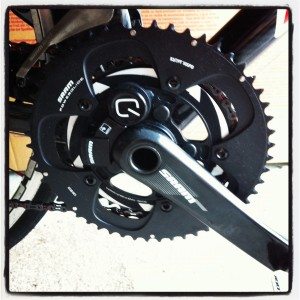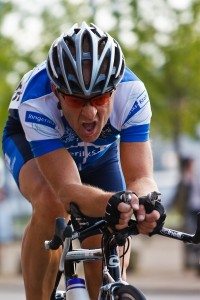 [dc]Y[dc]ou've all heard about anaerobic threshold, lactate threshold, threshold, red line, Zone 4, “the burn” and plenty of other terms that relate to the upper limits of your aerobic engine. But what a lot of people don't seem to understand is how to find that magical number, and what to do with it.
[dc]Y[dc]ou've all heard about anaerobic threshold, lactate threshold, threshold, red line, Zone 4, “the burn” and plenty of other terms that relate to the upper limits of your aerobic engine. But what a lot of people don't seem to understand is how to find that magical number, and what to do with it.
In this article, we'll examine the physiology behind anaerobic threshold and then you'll learn how to figure out what it is. I'll also discuss (very briefly) how you can use it to train towards becoming a stronger cyclist.
So without further ado….
What Is This Threshold Stuff and Why Do We Care?
In short terms, lactate or anaerobic threshold (from here on out abbreviated as LT) is the point at which your body switches from primarily aerobic metabolism to primarily anaerobic metabolism.
In reality, there's a LOT more going on than that. One of the keys to remember is that lactic acid is a by-product of anaerobic metabolism, and that is produced in all exercise intensities (even standing from a chair produces a small amount of lactic acid.) Under sub-threshold circumstances, this molecule is split into a lactate molecule and a free H+ ion, creating an acidic environment. Many believe this is the cause of muscle fatigue.
But is it?
Recent research has been shattering notions that lactic acid is the culprit of muscle fatigue, and for good reason. Research conducted in the last decade has shown that the breakdown of lactic acid into lactate actually consumes a pair of protons (those H+ that researches talked about for so long), and the even under the most intense exercise, muscular acidity never reaches a pH that (biochemically) causes contractile failure. Muscles always fatigue before they hit that catastrophic level of acidity, so really, what's the cause?
(Warning: physiology and biochemistry ahead. If you don't care to read it, skip ahead to the next section where we talk about threshold testing.)
Depolarization
What's that mean? Well, think of your muscles as an electrical system: contractions are stimulated by electric currents generated throughout the body by movement of sodium and potassium ions. Each muscle cell's contraction relies on a lightning quick exchange during which potassium ions inside the cell and sodium ions outside the cell switch places, and this process is facilitated by a high degree of polarization (difference in strength of electrical charge between the inside and outside of the cell.)
To put it simply, at the beginning of high intensity exercise, the inside of the cell is much more positive than the outside of the cell, making ion flow very easy to facilitate. As intense exercise continues, potassium ions are released from the muscle cell faster than they can be channeled back in via special “potassium pumps” in the cell membrane, which results in a buildup of potassium ions outside the cell. This causes a progressive decrease in the difference in charge between the inside and outside of the cells (depolarization), leading to weaker and less efficient contraction. We call this “fatigue.”
Lactate actually counteracts this. By a series of complex biochemical reactions, lactate produced by that same high intensity exercise helps to counteract depolarization, and thereby delaying fatigue. Unfortunately, nothing can stop depolarization completely, so continual high intensity exercise will eventually cause failure of the muscles to contract due to this biochemical fatigue.
Oh, and one other thing. In addition to counteracting fatigue, it's been discovered that lactate is actually fuel for muscle cells, and is one of the most easily utilized in the body.
Wow. So if lactate is so great, why does anyone care about threshold?
That Magical Number
The key to riding well is to limit the amount of time spent above LT. You want to limit biochemical fatigue (depolarization) and maximize our power below that magical level during which depolarization outstrips the body's ability to counteract it. As you continue to push harder, depolarization interferes with efficient and proper muscle contraction and as a result power output drops, suffering increases and you are forced to slow down. Fortunately, LT is one of the most trainable limiters in the body. This is truly why you should care about it so much
 From a practical standpoint, LT is the highest steady-state intensity that you can maintain for a prolonged period of time, which is generally described as an hour. This suggests that the best way to determine your LT is to perform a 60 minute time trial under race conditions. However, the chances that you have that data available to use as your LT are pretty slim. Thankfully, there are other reliable ways to find LT that don't involve race fees and a TT helmet.
From a practical standpoint, LT is the highest steady-state intensity that you can maintain for a prolonged period of time, which is generally described as an hour. This suggests that the best way to determine your LT is to perform a 60 minute time trial under race conditions. However, the chances that you have that data available to use as your LT are pretty slim. Thankfully, there are other reliable ways to find LT that don't involve race fees and a TT helmet.
The simplest way to find your LT is to do the following test, which can be done on a trainer (very mentally tough) or outside on a predominantly flat series of roads (avoid continuous rollers or significant climbs):
LT Test
- Warm up for about 15 minutes by spinning a nice easy gear, throwing in two or three 15 second hard efforts to open up the legs and prime your engine.
- Go out and ride a 30 minute TT at full gas, leaving nothing in the tank. Do not look at your heart rate. Do not look at your power. The only thing you'll ask yourself is “Am I going as hard as I can right now?”
- Record your heart rate (and power if you have it) for the entire duration of the TT (30 minutes).
- Warm down for 5-10 minutes by spinning easily.
 When you get home, you'll download and analyze your data. To find your LT heart rate (LTHR) you'll want to look at the final 20 minutes of your TT effort. The average HR during those last 20 minutes is a good approximation of you LTHR. If you are using a power meter, look at the average power for the last 20 minutes of the TT and subtract 5% to get a good approximation of your LT power (also called Functional Threshold Power or FTP.)
When you get home, you'll download and analyze your data. To find your LT heart rate (LTHR) you'll want to look at the final 20 minutes of your TT effort. The average HR during those last 20 minutes is a good approximation of you LTHR. If you are using a power meter, look at the average power for the last 20 minutes of the TT and subtract 5% to get a good approximation of your LT power (also called Functional Threshold Power or FTP.)
Bear in mind that if done on a trainer and done outside, power and HR numbers may be different. Changes in wind speed and direction, temperature and road conditions may raise or lower average LTHR or FTP numbers. Outdoor testing is by far the best option as it will compare to the real riding you're going to do on the road.
Final Thoughts On LTHR and FTP
While both LTHR and FTP are acceptable measures by which to set your training zones, there is a distinct difference between them. HR is a measure of input: the amount of physiological work your body is doing. Power is a measure of output: the amount of work your body is putting to the pedals. Measuring only input (HR) is a difficult way to determine training improvements since it is easily influenced by hydration, sleep, heat, humidity, mental state and other external (and internal) stresses. Power (output) is brutally honest in that it is a direct measure of the work you're doing (although comparing the two is a great way to note fitness gains.)
The bottom line is: use a power meter if you can. If you absolutely can't (or won't due to cost or any other factor) HR and LTHR will serve you fine, but you'll have to find some other ways to measure your changes in fitness.
Questions, comments, snarky remarks? Post below and start the party!